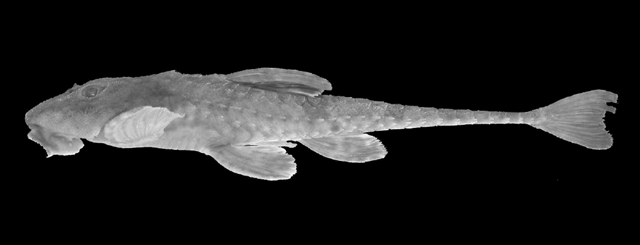| Loricariidae (Armored catfishes), subfamily: Loricariinae |
| 19.29 cm SL (male/unsexed) |
|
demersal; freshwater; pH range: 5.80000019073486 - 7.80000019073486; dH range: 20 |
| South America: Laguna dos Patos basin (Ref. 36389). Reported from the Paraná basin in Argentina (Ref. 56308). |
|
Possesses the characters of the rocky group and can be diagnosed within the species of the rocky group by the following characters: asymmetrical tooth cusps (vs. almost symmetrical cusps in Rineloricaria aequalicuspis); spotted color pattern in all fins (vs. a unique color pattern composed of one dark, wide band covering most of the distal one-half of all fins in Rineloricaria baliola); narrower head, head width 74.7-83.5 (vs. 83.7-93.6% of head length in Rineloricaria jaraguensis); 5-11 teeth in both dentary and premaxilla (vs. 12-16 teeth in each jaw in Rineloricaria latirostris); plated abdomen (vs. naked or almost naked in Rineloricaria malabarbai and Rineloricaria maquinensis); and short dorsal unbranched principal caudal-fin ray (vs. dorsal unbranched principal caudal-fin ray produced in a filament in Rineloricaria pentamaculata) (Ref. 75788). |
| Occurs in watercourses with slow to fast flow, clear to brown water with rocky, sandy, or muddy bottom (Ref. 75788). Encountered in polluted waters (Ref. 75788). |
|
Least Concern (LC); Date assessed: 07 November 2018 Ref. (130435)
|
| harmless |
Source and more info: www.fishbase.org. For personal, classroom, and other internal use only. Not for publication.

